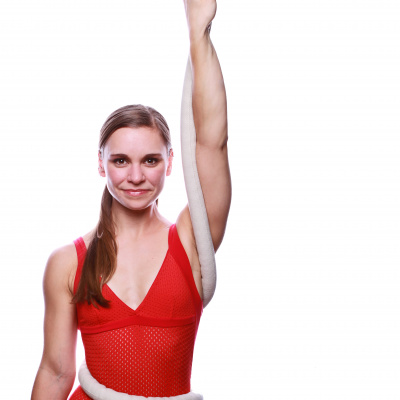The Rainbow is Enuf: an evolution, a healing, a joy
Last September, I spoke with Veronica Blair. She was cozied up in a long, red sweater just starting her day – it was a few hours earlier for her in San Francisco than it was for me in New York. Blair has a compelling way of being simultaneously serene and passionate. She exudes a charismatic, focused energy one might feel after meditation: grounded, thoughtful, forthright. I had recently seen her production The Rainbow is Enuf, which presented similar moods. It was a playful, authentic, and astute show was inspired by Ntozake Shange’s for colored girls who have considered suicide/when the rainbow is enuf. The interview was intended to result in a review of the show, but instead, it has found a (most appropriate) home here as the first article in the Women Making Circus About Women series.
Shange’s work premiered at New York City’s Booth Theater in 1976. Forty-six years later, the text has become, as Blair said, a genre of its own. “People are doing productions of it everywhere, all the time, and anyone can be involved in it. It was written by a Black woman and for Black women, but you see various productions with people of Asian descent, and Latinx descent.” Shange coined the term ‘choreopoem’ to describe the work, which includes a combination of poetic text, dance, and song. The unique composition, breadth, and length of the work have created its legacy.
I was curious how Blair saw her production fitting into this lineage. The show’s themes “are not unusual,” she said. “They’re not uncommon. I feel like everyone can relate to it. Doing my research and looking at so many different versions of the show with so many different casts wearing the colors of the rainbow, I was able to come up with ideas on how I wanted to interpret not only the themes in the show, but how I wanted the cast to be seen and show up on stage.”
Women Helping Women Make Circus
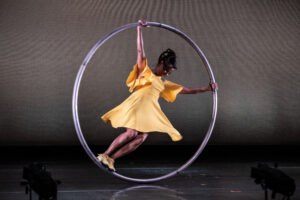
In 2009, Blair was in Japan on a contract with Susan Voyticky, a fellow circus performer and creator. They shared the idea that the choreopoem would make a good contemporary circus show. Ten years later, Blair nudged Voyticky about the idea, and they started planning. “We were going to gather together four female performers of African descent, start doing research, and start developing just a small version of the show… a workshop at Dixon Place in New York.” Blair shared the plans with Joanna Haigood at Zaccho Dance Theatre, based in San Francisco. Haigood responded, “Great! And can you do it in San Francisco as well?”
The ball was rolling. Voyticky was granted the Bindlestiff Family Cirkus’s First of May award, which supports the development of a full-length variety arts production. “I had met Darielle Williams somewhere down the road,” Blair said, “and I introduced her to the group. So now we were five: Susan Voyticky, myself, Copper Santiago, Summer Lacy, and Darielle.” Then, 2020 happened. The show moved online.
Another woman’s work, Anodea Judith’s Eastern Body Western Mind, was an important secondary source material. The cast followed the book’s subtitle, Psychology and the Chakra System as a Path to the Self, as an additional way to interpret Shange’s choreopoem. They asked, “What would make, for example, the root chakra (red) deficient? What are some of the ailments of it that cause it to be deficient, and how are we to heal it?” Looking at both sides of the coin, they also considered, what does it look like when a chakra is excessive, and how does one find balance between these two states? “We spent the time reading about each chakra and discussing how that relates to us and our stories in our lives, the lives of our parents, the lives of our ancestors as people of African descent. We ultimately ended up deciding on colors and chakras that represented us and that we felt specifically drawn to.” Weekly online meetings culminated in a film that fulfilled the First of May grant.
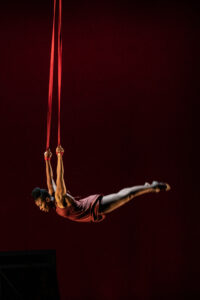
Creeping out of the pandemic, Blair knew this show needed a stage. She received two additional sources of funding: the Gerbode Foundation’s Choreography Award and the San Francisco Arts Commission. “I had a lot of support, and I also had the money to create this show,” Blair said, and leaned in toward the screen with a gesture of heft. Many hands make light work, and women helping women will make circus happen, but nothing can replace the importance of monetary funding.
Our Mothers and Their Mothers
Although Blair spoke to the universality of the text’s themes, one cannot ignore that almost fifty years have passed since for colored girlspremiered. I asked what pieces of Shange’s work were important to preserve in The Rainbow is Enuf. “Somewhere along the line, I remember having a conversation about us, as young Black women, not feeling as connected to the choreopoem – as women living in 2020, 2021, 2022.” Instead, “The Lady in Red, the Lady in Orange, the Lady in Yellow: taking on those characters [was important]. We felt like we wanted to take on the responsibility of having spoken word on stage as well as having the themes of each individual performance represent their [the cast’s] own personal inquiries or experiences – whatever they’re going through or whatever they’re working through in their own journey – which is quite different from what our mothers and what their mothers were working on and what they were struggling with.”
Blair also spoke about the cast’s consideration “that we had a bit more privilege than our mothers and our mothers’ mothers.” Making the show through the medium of contemporary circus was one of the privileges they identified. “The five of us women of African descent, having access to circus as an art form, as a medium, a source, an outlet for us as well as a career… I’ve been doing circus for twenty years; I’ve had my little struggles within my industry, but my mother and my mother’s mother would never imagine – they still kind of struggle with what I do!… At some point in our conversations, we really felt like we needed to have this moment where we were able to articulate physically: what are some of the issues for us? But we felt like they were also quite different from those of our parents and their parents.”
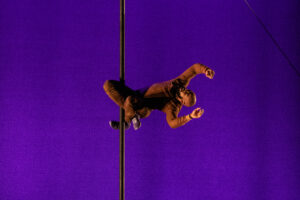
Blair explained that “the show was going to be called Colored Grrls, and then, with the addition of Toni [Cannon], who identifies as a male, we had to go back a little bit to the drawing board, happily. We had to think about how we wanted the group to be represented, because not everybody identifies as a girl. I mean, we were all grown women anyway! So why would we want to be called girls?” Blair explained how their research and dramaturgy blended, opening the show’s foundation of Shange’s rainbow to a deeper, human experience. “We as humans are living and experiencing a lot of radical things right now. We know that there’s the rainbow bridge, and going from the root chakra all the way to the crown doesn’t necessarily mean you’ve reached enlightenment. You also have to go back and work your way down. And that never ends – the healing process and the human experience – as long as you’re willing to participate. So, the rainbow is enuf. Is the rainbow enuf? It’s a statement, it’s a question, and it pays homage to the original text.”
Staged Stories
I saw The Rainbow is Enufin the fall of 2022, at The Muse Brooklyn. It was a sticky-hot, summery evening. The house was packed, and it was my favorite kind of mix of people – just enough familiar faces from the circus community to make it feel like a homecoming, and just enough strangers to make it feel like the work had reached through many communities. Tall, beige curtains framed the stage space.
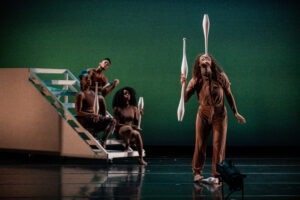
I arrived purposefully having not done my homework. I wanted to soak up the experience without any prior information to influence me. Coincidentally, this is how Blair would like audiences to approach the production. “I want people to walk into the show without any expectations or any judgments about what they think they’re going to see. That’s number one.”
Audiences who attended Shange’s original production, it seems, simply could not have been prepared for her work. It was so different, even radical, and it instigated mixed responses. Some people were outraged, particularly Black men, (Shange mentions this in her introduction to the 2010 reprint), feeling that Shange’s work was an attack on them. She writes (with a cool composure I imagine she exuded in life), “There was quite a ruckus about the seven ladies in their simple colored dresses… Methinks the gentlemen did protest too much… for colored girls was meant for women of color. The poems were addressing situations that bridged our secret (unspoken) longing. for colored girls still is a women’s trip, and the connection we can make through it, with each other and for each other, is to empower us all.” As time has passed, Shange mentions, the response has softened while the potency of the work remains. “Others now come to it with gentler eyes and less sensitive ears. They have grown. We all have. The preeminent poet Haki Madhubuti said it best. When I received the Gwendolyn Brooks Poetry Prize for Lifetime Achievement, Haki said to me simply, ‘We didn’t know.'”
We didn’t know means different realities were taking place side by side. We didn’t know means something wasn’t asked, something wasn’t told. Knowing is the first step toward understanding and empathy. If now we know, then the questions become, what have we done? What will we do?
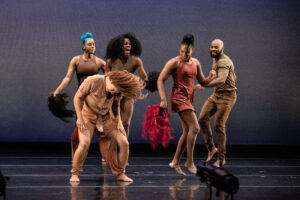
Awareness and Acceptance
Shange’s choreopoem is a hard read at times. There is suffering, and many tears. But there is also so much joy. Forty-six years later, The Rainbow is Enufis an evolution of the choreopoem. The show clearly portrays a journey of how ancestral pain can be recognized and transformed; how it can be honored and become a foundation for joy and strength. These are big, vague words – pain, honored, joy, strength – but Blair’s production is specific. Carefully crafted, every act brings the wholeness of each performer to the stage. Blair hopes audiences leave the production “transported into a state where they’re feeling and not so turned off.” For me, this was easily accomplished. The smart structure of the show that wove together solo and group moments and the engaging variety of music created a structure that I could recline into as I enjoyed the riveting circus acts. I left feeling uplifted, a witness to a celebration of Black joy.

Blair continued, “I hope that this show can be a catalyst in any small way for change in their [an audience member’s] own personal life. I want people to feel joy. I want them to feel excited about all of these stories of Blackness that are coming out in cinema, and in theaters, and dance, and all different types of mediums.” She expanded, “There are quite a few Black and Brown artists – circus artists in particular – that are here. We’ve been here for a while, and we have these stories. And these stories are unique to us and our experiences. They also deserve to be told, and they’re probably not that different than yours. The way that we express and we move through our bodies is probably not what most people are used to seeing. I feel like with Black and Brown bodies, sometimes movement develops over the course of that three to six-minute [act]. It’s a warming up of movements and expressions to the crescendo. There’s a different way that we express. And I guess, in some way, the little girl in me still wants people to leave with a little bit more acceptance and awareness.”
The Next Evolution
Blair looks forward to “more funds, more residencies to fill out the show. It was a wonderful first draft,” she said. Other goals include “having seven performers to round out the show, touring it to fringe festivals around the world, playing theaters here in America – because it’s very much an American circus show, and very proud to be!” I couldn’t agree more with Blair when she pressed the importance of “exposing Americans to contemporary circus by homegrown artists.” And Blair wasn’t shy to throw a run on Broadway in the mix.
Below: trailer for The Rainbow is Enuf at the San Francisco Aerial Arts Festival.
All images by Austin Forbord. Commissioned by Zaccho Dance Theatre and performed in the 2022 SF Aerial Arts Festival....
Do you have a story to share? Submit your news story, article or press release.


